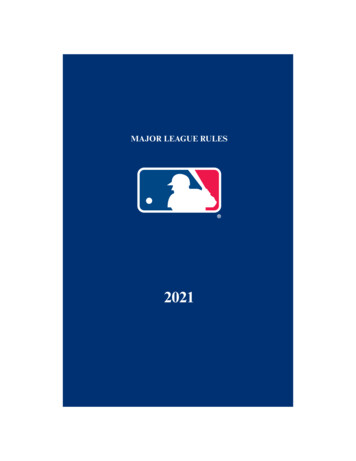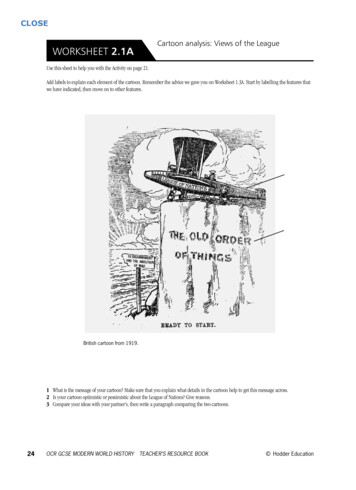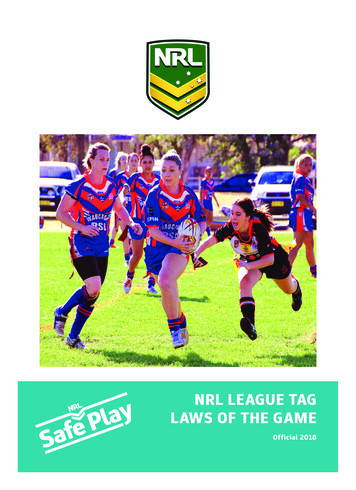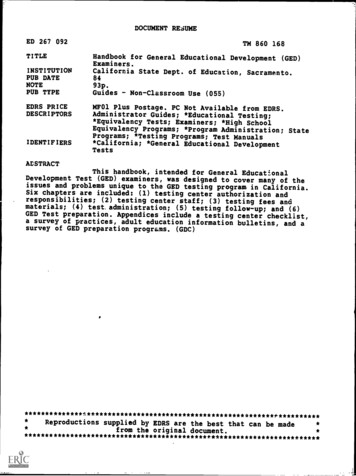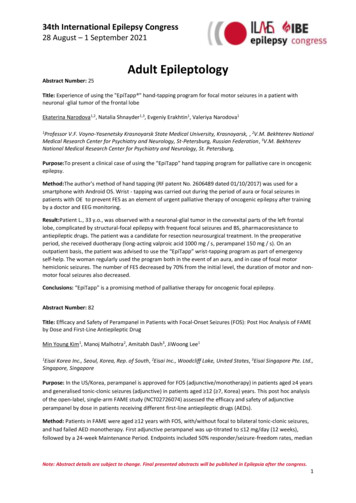
Transcription
34th International Epilepsy Congress28 August – 1 September 2021Adult EpileptologyAbstract Number: 25Title: Experience of using the "EpiTapp " hand-tapping program for focal motor seizures in a patient withneuronal -glial tumor of the frontal lobeEkaterina Narodova1,2, Natalia Shnayder1,3, Evgeniy Erakhtin1, Valeriya Narodova11Professor V.F. Voyno-Yasenetsky Krasnoyarsk State Medical University, Krasnoyarsk, , 2V.M. Bekhterev NationalMedical Research Center for Psychiatry and Neurology, St-Petersburg, Russian Federation, 3V.M. BekhterevNational Medical Research Center for Psychiatry and Neurology, St. Petersburg,Purpose:To present a clinical case of using the “EpiTapp” hand tapping program for palliative care in oncogenicepilepsy.Method:The author's method of hand tapping (RF patent No. 2606489 dated 01/10/2017) was used for asmartphone with Android OS. Wrist - tapping was carried out during the period of aura or focal seizures inpatients with OE to prevent FES as an element of urgent palliative therapy of oncogenic epilepsy after trainingby a doctor and EEG monitoring.Result:Patient L., 33 y.o., was observed with a neuronal-glial tumor in the convexital parts of the left frontallobe, complicated by structural-focal epilepsy with frequent focal seizures and BS, pharmacoresistance toantiepileptic drugs. The patient was a candidate for resection neurosurgical treatment. In the preoperativeperiod, she received duotherapy (long-acting valproic acid 1000 mg / s, perampanel 150 mg / s). On anoutpatient basis, the patient was advised to use the “EpiTapp” wrist-tapping program as part of emergencyself-help. The woman regularly used the program both in the event of an aura, and in case of focal motorhemiclonic seizures. The number of FES decreased by 70% from the initial level, the duration of motor and nonmotor focal seizures also decreased.Conclusions: “EpiTapp” is a promising method of palliative therapy for oncogenic focal epilepsy.Abstract Number: 82Title: Efficacy and Safety of Perampanel in Patients with Focal-Onset Seizures (FOS): Post Hoc Analysis of FAMEby Dose and First-Line Antiepileptic DrugMin Young Kim1, Manoj Malhotra2, Amitabh Dash3, JiWoong Lee11Eisai Korea Inc., Seoul, Korea, Rep. of South, 2Eisai Inc., Woodcliff Lake, United States, 3Eisai Singapore Pte. Ltd.,Singapore, SingaporePurpose: In the US/Korea, perampanel is approved for FOS (adjunctive/monotherapy) in patients aged 4 yearsand generalised tonic-clonic seizures (adjunctive) in patients aged 12 ( 7, Korea) years. This post hoc analysisof the open-label, single-arm FAME study (NCT02726074) assessed the efficacy and safety of adjunctiveperampanel by dose in patients receiving different first-line antiepileptic drugs (AEDs).Method: Patients in FAME were aged 12 years with FOS, with/without focal to bilateral tonic-clonic seizures,and had failed AED monotherapy. First adjunctive perampanel was up-titrated to 12 mg/day (12 weeks),followed by a 24-week Maintenance Period. Endpoints included 50% responder/seizure-freedom rates, medianNote: Abstract details are subject to change. Final presented abstracts will be published in Epilepsia after the congress.1
34th International Epilepsy Congress28 August – 1 September 2021percent change in seizure frequency/28 days and treatment-emergent adverse events (TEAEs). For thisanalysis, endpoints were stratified by first-line AED and perampanel maintenance dose.Result: First-line AEDs included levetiracetam, carbamazepine, oxcarbazepine, lamotrigine and valproic acid.Perampanel maintenance doses were 4–12 mg/day. In the Full Analysis Set (n 85), efficacy appeared greatestwith perampanel 4 or 6 mg/day: at 4 mg/day, 50% responder rates were 85% with levetiracetam (n 17/20) and100% with carbamazepine (n 7/7), oxcarbazepine (n 7/7), lamotrigine (n 6/6) and valproic acid (n 2/2), whilemedian percent reductions in seizure frequency were 97–100% with each first-line AED. Seizure-freedom rateswere highest with perampanel 4 mg/day plus oxcarbazepine (86%, n 6/7) or valproic acid (100%; n 2/2).Sample sizes were small for perampanel 10–12 mg/day (n 3). In the Safety Analysis set (n 102), the mostcommon TEAE (dizziness) was generally observed most frequently with perampanel 4 mg/day. Eight patientshad serious adverse events; one of suicidal ideation with perampanel 4 mg/day and levetiracetam wasconsidered possibly related to treatment, while all others were considered unrelated.Conclusions: Low-dose perampanel (4–6 mg/day) was effective in achieving seizure control and response withfavourable tolerability in patients with FOS, regardless of first-line concomitant AED use.Funding: Eisai Korea Inc.Abstract Number: 120Title: Efficacy/Safety of Adjunctive Perampanel for Myoclonic and Absence Seizures: Post Hoc Analysis ofPatients Aged 2 Years in Studies 332/311/232Christian Brandt1, J Ben Renfroe2, Leock Y Ngo3, Anna Patten4, Manoj Malhotra31Bethel Epilepsy Center, Bielefeld, Germany, 2Child Neurology Center of Northwest Florida, Gulf Breeze , UnitedStates, 3Eisai Inc. , Woodcliff Lake, United States, 4Eisai Europe Ltd., Hatfield, United KingdomPurpose:Some anti-seizure medications can exacerbate myoclonic and absence seizures in patients withgeneralised seizures. As such, this post hoc pooled analysis assessed the efficacy and safety of adjunctiveperampanel for myoclonic and absence seizures in adult/adolescent/paediatric patients using data from PhaseII/III clinical studies.Method: During the randomised, double-blind Study 332 (NCT01393743), patients aged 12 years withgeneralised tonic-clonic seizures (GTCS) received placebo or adjunctive perampanel 8 mg/day. In Study 311(NCT02849626), patients aged 4– 12 years with focal-onset seizures or GTCS received open-label perampanel 16 mg/day. In Study 232 (NCT01527006), patients aged 2– 12 years with epilepsy received open-labelperampanel 0.18 mg/kg/day. Data from patients with myoclonic and/or absence seizures during baselinewere pooled. Assessments included median percent change in seizure frequency/28 days, 50% responder ratesand treatment-emergent adverse events (TEAEs).Result: Of 393 patients, 66 had myoclonic seizures (placebo, n 23 [mean (standard deviation) age: 28.1 (8.9)years]; perampanel, n 43 [18.8 (11.9) years]) and 72 had absence seizures (placebo, n 33 [28.8 (13.2) years];perampanel, n 39 [21.0 (12.2) years]) at baseline; patients with both seizure types are counted in both groups.Reductions in seizure frequency/28 days were observed in both the placebo and perampanel groups:myoclonic, 52.5% and 24.6%; absence, 7.6% and 25.1%, respectively. For placebo and perampanel, 50%responder rates were: myoclonic, 60.9% (n 14/23) and 44.2% (n 19/43); absence, 39.4% (n 13/33) and 38.5%(n 15/39), respectively. TEAEs with placebo and perampanel occurred in 18 (78.3%) and 36 (83.7%) patientsNote: Abstract details are subject to change. Final presented abstracts will be published in Epilepsia after the congress.2
34th International Epilepsy Congress28 August – 1 September 2021with myoclonic seizures, and 25 (75.8%) and 34 (87.2%) patients with absence seizures, respectively. Withperampanel, the most common TEAEs were dizziness and fatigue.Conclusions: Despite small patient numbers, these data suggest adjunctive perampanel does not worsenmyoclonic or absence seizures in adult, adolescent and paediatric patients.Funding: Eisai Inc.Abstract Number: 124Title: PROVE Study 506: Perampanel as Adjunctive Therapy or Monotherapy in Real-World Clinical Care ofPatients with EpilepsyRuben Kuzniecky1, Robert T. Wechsler2, Anna Patten3, Manoj Malhotra41Zucker School of Medicine at Hofstra/Northwell, Hempstead, United States, 2Comprehensive Epilepsy Center,Boise, United States, 3Eisai Europe Ltd., Hatfield, United Kingdom, 4Eisai Inc. , Woodcliff Lake, United StatesPurpose: Perampanel is a once-daily oral anti-seizure medication (ASM) for focal-onset seizures andgeneralised tonic-clonic seizures. We report a subgroup analysis of the retrospective, non-interventional PhaseIV PROVE Study 506 (NCT03208660), comparing retention, dosing and safety for patients with epilepsy whoreceived adjunctive perampanel or perampanel monotherapy during routine clinical care.Method: Data were obtained from records of patients initiating perampanel after 01-Jan-2014. Follow-upcompleted on 15-Mar-2019. Primary endpoint was retention rate (proportion of patients in Safety Analysis Set[SAS] remaining on perampanel at 3/6/12/18/24 months following initiation). Dosing/safety were secondaryobjectives. Patients received perampanel as adjunctive therapy (with concomitant ASMs), primarymonotherapy (without concomitant ASMs) or secondary monotherapy (conversion to monotherapy bywithdrawing concomitant ASMs).Results: SAS included 1676 (98.4%) patients receiving adjunctive perampanel and 47 (2.8%) receivingperampanel monotherapy (mean [standard deviation (SD)] age, 28.4 [16.4] and 31.5 [18.2] years; female,52.7% and 53.2%, respectively). Patients receiving adjunctive perampanel and perampanel monotherapy(primary, n 33; secondary, n 14) are included in each relevant group. Most patients on adjunctive perampanelreceived 1–3 baseline ASMs (n 1321 [77.6%]). Overall, 806 (48.1%) patients discontinued adjunctiveperampanel and 23 (48.9%) discontinued monotherapy; most commonly due to adverse events (adjunctive,22.9%; monotherapy, 14.9%) and inadequate therapeutic effect (adjunctive, 13.1%; monotherapy, 25.5%).Retention rates on perampanel (24 months) were: 47.6% (adjunctive); 31.3% (primary monotherapy); 83.3%(secondary monotherapy). Mean (SD) cumulative durations of perampanel exposure were: adjunctive, 17.3(15.8) months; monotherapy, 13.5 (11.8) months. Mean (SD) maximum perampanel doses were: adjunctive,6.6 (3.2) mg; monotherapy, 7.2 (2.7) mg. Treatment-emergent adverse events occurred in 696 (adjunctive;41.5%) and 17 (monotherapy; 36.2%) patients; dizziness was most common.Conclusion: This analysis demonstrates favourable retention on perampanel (adjunctive or monotherapy) for 2 years in patients with epilepsy during routine clinical care, with similar safety profiles between groups.Funding: Eisai Inc.Note: Abstract details are subject to change. Final presented abstracts will be published in Epilepsia after the congress.3
34th International Epilepsy Congress28 August – 1 September 2021Abstract Number: 125Title: PROVE Study 506: Analysis of a Retrospective, Phase IV Study of Perampanel in Real-World Clinical Careof Patients Based on Seizure TypeJames Wheless1, Anna Patten2, Leock Y Ngo3, Alejandro Salah4, Manoj Malhotra31University of Tennessee Health Science Center, Le Bonheur Children’s Hospital, Memphis, , 2Eisai Europe Ltd.,Hatfield, United Kingdom, 3Eisai Inc. , Woodcliff Lake, United States, 4Formerly Eisai Inc. , Woodcliff Lake, UnitedStatesPurpose: PROVE (NCT03208660) was a retrospective, multicentre, non-interventional Phase IV study ofperampanel during real-world clinical care of patients with epilepsy. We report real-world efficacy and safety ofperampanel from PROVE, based on baseline seizure type.Method: Data were obtained from records of patients initiating perampanel after 01-Jan-2014. Follow-upcompleted on 15-Mar-2019. Primary endpoint was retention rate (proportion of patients remaining onperampanel at 3/6/12/18/24 months following initiation; Safety Analysis Set [SAS]). Dosing, efficacy and safetywere secondary objectives. Outcomes were stratified by baseline seizure type: focal-onset seizures (FOS) only,generalised seizures only, generalised tonic-clonic seizures (GTCS) only, myoclonic and absence seizures. Thereis overlap between the generalised seizure groups; patients with FOS and generalised seizures (n 718) wereexcluded.Result: SAS included 1703 patients. Mean (standard deviation) maximum doses (mg/day) were: FOS only(n 545), 6.9 (3.0); generalised only (n 440), 6.0 (3.1); GTCS only (n 110), 6.2 (3.0); myoclonic (n 328), 6.4 (3.2);absence (n 301), 6.5 (3.3). 24-month retention rates were: 48.1% (FOS only, n 164/341); 47.8% (generalisedonly, n 120/251); 42.9% (GTCS only, n 27/63); 50.3% (myoclonic, n 100/199); 47.7% (absence, n 84/176). Of51 patients with seizure data at Months 22–24, median reductions in total seizure frequency/28 days were:75.0% (FOS only, n 20); 91.6% (generalised only, n 10); 40.0% (GTCS only, n 3); 70.0% (myoclonic, n 7);100.0% (absence, n 4). Corresponding seizure-freedom rates were: 45.0% (FOS only, n 9/20); 30.0%(generalised only, n 3/10); 0.0% (GTCS only, n 0/3); 14.3% (myoclonic, n 1/7); 75.0% (absence, n 3/4); 50%responder rates were 33.3–100.0% across seizure types. Treatment-emergent adverse events occurred in231/545 (42.4%; FOS only), 185/440 (42.0%; generalised only), 50/110 (45.5%; GTCS only), 117/328 (35.7%;myoclonic) and 154/301 (51.2%; absence) patients; the most common were dizziness and aggression.Conclusions: Dosing, 24-month retention rates on perampanel and safety were generally similar across seizuretypes. Seizure frequency reductions were observed across subgroups.Funding: Eisai Inc.Abstract Number: 126Title: Adjunctive Perampanel 4 mg/day for Focal-Onset Seizures (FOS): Time to Seizure Onset in Pivotal Phase IIIStudiesAlejandro Salah1, Anna Patten2, Manoj Malhotra31Formerly Eisai Inc. , Woodcliff Lake, United States, 2Eisai Europe Ltd., Hatfield, United Kingdom, 3Eisai Inc. ,Woodcliff Lake, United StatesPurpose: Although recommended maintenance dosing of perampanel for FOS is 8–12 mg/day, in somepatients, efficacy can be seen with doses as low as 4 mg/day. This post hoc analysis evaluated the efficacy ofNote: Abstract details are subject to change. Final presented abstracts will be published in Epilepsia after the congress.4
34th International Epilepsy Congress28 August – 1 September 2021adjunctive perampanel 4 mg/day for treatment of FOS, with/without focal to bilateral tonic-clonic seizures(FBTCS), by assessing time to first seizure following perampanel administration.Method: During Phase III Studies 304 (NCT00699972), 305 (NCT00699582) and 306 (NCT00700310), patients(aged 12 years) with FOS, with/without FBTCS, despite 1–3 anti-seizure medications were randomised toonce-daily placebo or adjunctive perampanel 2–12 mg/day (19-week Double-blind Treatment Period [6-weekTitration; 13-week Maintenance]). Time to first seizure from Day 1 of placebo or perampanel administrationwas assessed in the Intent-to-Treat (ITT) Analysis Set using the Kaplan–Meier method. Placebo data wereavailable from Studies 304, 305 and 306; perampanel 4 mg/day data came from Study 306 (the only study toinclude the randomised 4-mg/day dose).Results: The ITT Analysis Set included 437/442 (98.9%) placebo-treated patients (182/185 [98.4%] from Study306) and 168/172 (97.7%) patients who received perampanel 4 mg/day. Perampanel 4 mg/day was associatedwith longer time to first seizure vs placebo. Mean (standard deviation) time to first seizure was 9.3 (22.80) dayswith perampanel 4 mg/day vs 4.9 (7.10) and 4.5 (6.33) days for Study 306 placebo and pooled placebo,respectively; median (range) time to first seizure was 3 (1, 135), 3 (1, 73) and 3 (1, 73) days, respectively.Conclusion: Adjunctive treatment with once-daily perampanel 4 mg/day delayed the time to first seizure inpatients aged 12 years with FOS, with/without FBTCS, compared with placebo. These data further support theefficacy of perampanel 4 mg/day.Funding: Eisai Inc.Abstract Number: 127Title: FAME Study: Efficacy and Safety of Perampanel as First Adjunctive Therapy after First or SecondMonotherapy in Patients with Focal-Onset SeizuresJi Hyun Kim1, Dong Wook Kim2, Amitabh Dash3, JiWoong Lee4, Manoj Malhotra51Korea University Guro Hospital, Seoul, Korea, Rep. of South, 2Konkuk University School of Medicine, Seoul,Korea, Rep. of South, 3Eisai Singapore Pte. Ltd., Singapore, Singapore, 4Eisai Korea Inc., Seoul, Korea, Rep. ofSouth, 5Eisai Inc., Woodcliff Lake, United StatesPurpose: In the US/Korea, perampanel is approved for focal-onset seizures (FOS) (adjunctive/monotherapy) inpatients aged 4 years and generalised tonic-clonic seizures (adjunctive) in patients aged 12 ( 7, Korea) years.This post hoc analysis of the open-label, single-arm FAME study (NCT02726074) explored whether the efficacyand safety of first adjunctive perampanel is impacted by the number of previous monotherapies (one or two).Method: Patients in FAME were aged 12 years with FOS with/without focal to bilateral tonic-clonic seizures(FBTCS) and had failed antiepileptic drug monotherapy. Perampanel was up-titrated to 12 mg/day (12 weeks),followed by a 24-week Maintenance Period. Endpoints included 50% responder/seizure-freedom rates, medianpercent change in seizure frequency/28 days and treatment-emergent adverse events (TEAEs). For thisanalysis, endpoints were stratified by whether the prior treatment was a first or second monotherapy.Results: The Full Analysis Set included 79 patients receiving perampanel 4–10 mg/day with first monotherapies(most commonly: levetiracetam [n 31]; carbamazepine [n 20]; oxcarbazepine [n 14]) and six receivingperampanel 6–12 mg/day with second monotherapies (levetiracetam [n 3]; oxcarbazepine [n 3]). For first vssecond monotherapy, 50% responder rates were 83.5% (n 66/79) vs 33.3% (n 2/6; P 0.0134), seizure-freedomrates were 50.6% (n 40/79) vs 0.0% (n 0/6; P 0.0274) and median percent reductions in seizure frequency/28days were 100.0% vs 21.8% (P 0.0039). In patients with FBTCS (all first monotherapy), the seizure-freedom ratewas 75.0% (n 12/16). In the Safety Analysis Set, TEAE profiles were similar with first vs second monotherapyNote: Abstract details are subject to change. Final presented abstracts will be published in Epilepsia after the congress.5
34th International Epilepsy Congress28 August – 1 September 2021(TEAE incidence: 75.3% [n 70/93] vs 77.8% [n 7/9]; serious TEAEs: 6.5% [n 6/93] vs 22.2% [n 2/9];discontinuations due to TEAEs: 14.0% [n 13/93] vs 11.1% [n 1/9]; most common TEAE in both groups:dizziness).Conclusion: Adjunctive perampanel was associated with improved seizure control following first or secondmonotherapy. However, the small number of patients on their second monotherapy limits comparisons. Thesedata support early-line perampanel use.Funding: Eisai Korea Inc.Abstract Number: 128Title: Safety of Adjunctive Perampanel by Titration/Maintenance Periods and Dose in Patients With Focal-OnsetSeizures: Post hoc Analysis of the FAME StudyDong Wook Kim1, Ji Hyun Kim2, Amitabh Dash3, JiWoong Lee4, Manoj Malhotra51Konkuk University School of Medicine, Seoul, Korea, Rep. of South, 2Korea University Guro Hospital, Seoul,Korea, Rep. of South, 3Eisai Singapore Pte. Ltd., Singapore, Singapore, 4Eisai Korea Inc., Seoul, Korea, Rep. ofSouth, 5Eisai Inc., Woodcliff Lake, United StatesPurpose: In the US/Korea, perampanel is approved for focal-onset seizures (FOS) (adjunctive/monotherapy) inpatients aged 4 years, and generalised tonic-clonic seizures (adjunctive) in patients aged 12 ( 7, Korea)years. This post hoc analysis of the open-label, single-arm FAME study (NCT02726074) assessed the safety ofperampanel by study period/dose.Method: Patients were aged 12 years with FOS, with/without focal to bilateral tonic-clonic seizures (FBTCS)and had failed antiepileptic drug monotherapy. First adjunctive perampanel was up-titrated to 12 mg/day (12weeks), followed by a 24-week Maintenance Period. Endpoints included 50% responder/seizure-freedom rates,median percent change in seizure frequency/28 days and treatment-emergent adverse events (TEAEs). Forthese analyses, safety was assessed during Titration vs Maintenance and safety/efficacy were assessed byperampanel maintenance dose.Results: Overall, 75.5% (77/102) of patients in the Safety Analysis Set reported 138 TEAEs, most commonlydizziness (50.0% [n 51/102]), somnolence (9.8% [n 10/102]) and headache (8.8% [n 9/102]). TEAEs occurredin 62.7% (n 64/102) of patients during Titration and 24.5% (n 25/102) during Maintenance. Among 88 patientswho received maintenance perampanel 4, 6, 8, 10 or 12 mg/day, TEAE incidences across both study periodswere 77.8% (n 35/45), 75.0% (n 21/28), 58.3% (n 7/12), 50.0% (n 1/2) and 100% (n 1/1), respectively. In theFull Analysis Set (n 85), 0/3 patients receiving perampanel 10/12 mg/day achieved 50% response, but efficacyat lower maintenance doses was demonstrated by 50% responder rates (4 mg/day, 93.0% [n 40/43]; 6 mg/day,81.5% [n 22/27]; 8 mg/day, 50.0% [n 6/12]), seizure-freedom rates (4 mg/day, 60.5% [n 26/43]; 6 mg/day,44.4% [n 12/27]; 8 mg/day, 16.7% [n 2/12]) and median percent reductions in seizure frequency/28 days (4mg/day, 100.0%; 6 mg/day, 91.9%; 8 mg/day, 45.8%).Conclusion: TEAE rates were lower during Maintenance than Titration, suggesting improved tolerance oncemaintenance doses were reached. While few patients received high doses, perampanel was otherwisegenerally well tolerated/efficacious regardless of dose.Funding: Eisai Korea Inc.Note: Abstract details are subject to change. Final presented abstracts will be published in Epilepsia after the congress.6
34th International Epilepsy Congress28 August – 1 September 2021Abstract Number: 132Title: Disorders of reproduction in young men suffering from epilepsyAnna Voitiuk11Kharkiv Medical Academy of Postgraduate Education, Department of Neurology and Child Neurology, Kharkiv,UkraineBackground: The pathology of the reproductive system in epileptic men can manifest itself both in the form ofdecreased libido, decreased fertility, erectile dysfunction, orgasm and ejaculation disorders, and lead toinfertility. The study involved 30 men aged 18–44 years (31.8 2.12), who were divided into two groups. GroupI (14 patients) with congenital central nervous system abnormalities, and group II (16 patients) with posttraumatic epilepsy (the median time is 1.6 years). A control group of 15 practically healthy men of comparableage was formed.Purpose: to evaluate of the effect of epilepsy on the male reproductive system.Method: The study included neurological examination, a validated questionnaire "International Index ofErectile Function" (IIEF).Result: It was found in the course of the study that the average score on the IIEF questionnaire was 13.6 ingroup I, which corresponds to moderate erectile dysfunction. There was a statistically significant differencewith the control group (p 0.01). This measure was 22.8 in group II, which actually indicates a normal erection.There was no significant difference with the control group in this indicator (p 0.05). The 11 (78.6%) patientsfrom group I noted the absence of pronounced morning erections and weak masturbation erections, whichallowed to exclude psychogenic erectile dysfunction. The men from the control group and group II noted thepreservation of morning erections. Also, young men from group I were significantly more likely to haveasthenozoospermia (71.4 % compared to 20% of the control group; p 0.05).Conclusions: According to the results of the study, it was found out that erectile dysfunction and impairedfertility are more common in people with epilepsy since childhood and adolescence. In contrast, amongpatients with post-traumatic epilepsy and a short duration of the disease, erectile dysfunction is not morecommon than in the general population.Abstract Number: 133Title: Changes of lipid metabolism in young men with epilepsyAnna Voitiuk1,21Kharkiv Medical Academy of Postgraduate Education, Department of Neurology and Child Neurology, Kharkiv,Ukraine, 2Medical Centre "Neuron", Kharkiv, UkraineBackground: Epilepsy is one of the most common diseases of the nervous system. It is known that the basis ofthe disease is increased epileptiform activity, due to the peculiarities of the course of the brain's metabolicprocesses. A certain role is played by endocrine disorders and metabolic disorders, in particular.Purpose: to investigate the changes in lipid metabolism in young men with epilepsy in the post-seizure periodand against the background of taking antiepileptic drugs (AEDs).Method: The studies were conducted on the basis of the analysis of clinical symptoms and instrumental studies(biochemical blood analysis - lipid spectrum, determination of the level of AEDs concentration in the blood). EEG,EEG-video monitoring, MRI, Proton MR Spectroscopy (definition of Lip, Lac) were used as the screening methods.Note: Abstract details are subject to change. Final presented abstracts will be published in Epilepsia after the congress.7
34th International Epilepsy Congress28 August – 1 September 2021Result: The analysis of the data of 50 young men aged from 18 to 44. After the survey 25 people in the postseizure period had a Lac peak and 5 people had a Lip peak, which occurs when lipid peroxidation processes aredisrupted. Such disorders of lipid metabolism may be one of the factors of neuronal membrane damage. Changesin lipidic metabolism are associated with some AEDs and may cause long-term adverse health effects. Thesechanges were observed in 15 patients. Carbamazepine (CBZ), phenobarbital (PB) and phenytoin (PHT) increasehigh-density lipoproteins, CBZ has cholesterol-lowering effects, PB and PHT may exert a similar cholesterollowering effect.Conclusions: All patients showed multidirectional changes in lipid metabolism, which require further study.Disorders of lipid metabolism largely depend on the intake and daily dosage of AEDs.Abstract Number: 138Title: Sustained Seizure Freedom with Perampanel 4 mg/day Monotherapy in Patients with NewlyDiagnosed/Currently Untreated Focal-Onset Seizures: Study 342Yuichi Kubota1,2, Ji Hyun Kim3, Sung Chul Lim4, Hirotomo Ninomiya5, Takamichi Yamamoto6, Anna Patten7,Leock Y Ngo8, Manoj Malhotra81TMG Asaka Medical Center, Saitama, Japan, 2Present address: Tokyo Women’s Medical University MedicalCenter East, Tokyo, Japan, 3Korea University Guro Hospital, Seoul, Korea, Rep. of South, 4The Catholic Universityof Korea, St. Vincent Hospital, Gyeonggi-do, Korea, Rep. of South, 5Itami City Hospital, Hyogo, Japan, 6SeireiHamamatsu General Hospital, Hamamatsu, Japan, 7Eisai Europe Ltd., Hatfield, United Kingdom, 8Eisai Inc.,Woodcliff Lake, United StatesPurpose: FREEDOM (NCT03201900; Japan/South Korea) is a multicentre, open-label Phase III study ofperampanel monotherapy in patients (aged 12–74 years) with newly diagnosed/currently untreated recurrentfocal-onset seizures (FOS), with/without focal to bilateral tonic-clonic seizures (FBTCS). We assessed if seizurefreedom with perampanel 4 mg/day achieved during the Core Study is maintained during 52 weeks’ treatment.Method: During the Core Study, patients received perampanel 4 mg/day (4-week Pretreatment; 32-weekTreatment [6-week Titration; 26-week Maintenance]), with titration up to 8 mg/day in case of seizure. Patientscompleting the Core Study could enter an Extension Phase. Seizure-freedom rates for 52 weeks(Core/Extension Phases) at 4 mg/day for FOS and based on seizure history were assessed in patients who wereseizure free during the 4-mg/day Core Study Maintenance Period. Treatment-emergent adverse events (TEAEs)were monitored.Results: Eighty-nine patients received 1 perampanel dose (Safety Analysis Set [SAS]) and 73 entered theMaintenance Period (modified Intent-to-Treat [mITT] population). Seizure freedom for 26 weeks was achievedby 46/73 (63.0%) patients with FOS during Maintenance. Of 32 patients who chose to enter the ExtensionPhase, 20 (62.5% [27.4% of the mITT population (n 20/73)]) achieved sustained seizure freedom at 4 mg/dayfor 52 weeks; 4 patients had not completed 52 weeks of treatment at data cutoff. Based on patients in themITT who entered the Extension Phase, 55% of patients with a history of focal impaired awareness seizures(FIAS), FIAS and/or FBTCS or FBTCS had sustained seizure freedom for 52 weeks on perampanel 4 mg/day.TEAEs occurred in 72 (80.9%) patients in the SAS (Core and Extension Phases); most common was dizziness(36.0%).Conclusion: Seizure freedom was sustained during long-term (52 weeks) treatment with perampanelmonotherapy 4 mg/day in patients with newly diagnosed/currently untreated recurrent FOS with/withoutFBTCS. Perampanel 4 mg/day was well tolerated.Funding: Eisai Co., Ltd.Note: Abstract details are subject to change. Final presented abstracts will be published in Epilepsia after the congress.8
34th International Epilepsy Congress28 August – 1 September 2021Abstract Number: 142Title: Clinical Factors Associated with Seizure Freedom in Patients with Focal-Onset Seizures (FOS) ReceivingPerampanel 4 mg/day in FREEDOM Study 342Takamichi Yamamoto1, Anna Patten2, Ji Hyun Kim3, Sung Chul Lim4, Hirotomo Ninomiya5, Yuichi Kubota6,7,Manoj Malhotra81Seirei Hamamatsu General Hospital, Hamamatsu, Japan, 2Eisai Europe Ltd., Hatfield, United Kingdom, 3KoreaUniversity Guro Hospital, Seoul, Korea, Rep. of South, 4The Catholic University of Korea, St. Vincent Hospital,Seoul, Korea, Rep. of South, 5Itami City Hospital, Hyogo, Japan, 6TMG Asaka Medical Center, Saitama, Japan,7Present address: Tokyo Women’s Medical University Medical Center East, Tokyo, Japan, 8Eisai Inc. , WoodcliffLake, United StatesPurpose: Previous analyses have identified factors that affect treatment responses, e.g. high baseline seizurefrequency has been associated with poor prognosis (French JA. Epilepsy Curr 2002;2:69–71). This post hocanalysis identified predictive clinical factors for patients (aged 12–74 years) with FOS, with/without focal tobilateral tonic-clonic seizures (FBTCS), achieving 26 weeks’ seizure freedom while receiving perampanel 4mg/day during FREEDOM Study 342 (NCT03201900).Method: This analysis was based on the 4-mg/day Treatment Phase (6-week Titration; 26-week Maintenance).Logistic regression was used to determine odds ratios (ORs) and 95% confidence intervals (CIs). Goodness of fitwas measured by area under the receiver operating characteristic (ROC)
TEAEs with placebo and perampanel occurred in 18 (78.3%) and 36 (83.7%) patients . 34th International Epilepsy Congress 28 August - 1 September 2021 Note: Abstract details are subject to change. Final presented abstracts will be published in Epilepsia after the congress. 3
